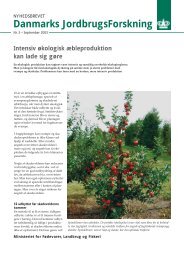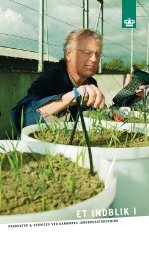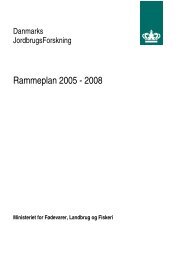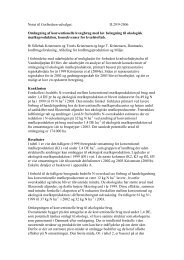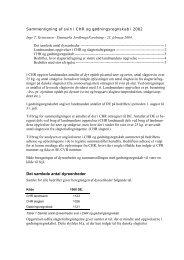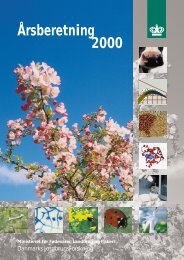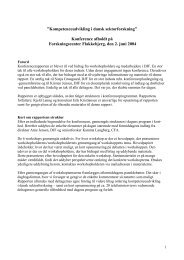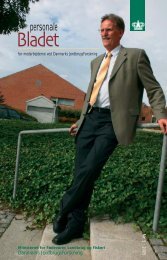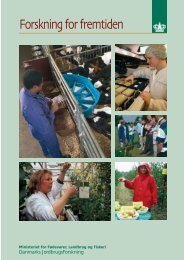Reproduction performances and conditions of group-housed non ...
Reproduction performances and conditions of group-housed non ...
Reproduction performances and conditions of group-housed non ...
You also want an ePaper? Increase the reach of your titles
YUMPU automatically turns print PDFs into web optimized ePapers that Google loves.
- Background <strong>and</strong> aim -<br />
systems <strong>and</strong> shows that <strong>group</strong> housing do not ‘automatically’ lead to poor reproduction<br />
performance.<br />
This is further supported by indications <strong>of</strong> a large variation in reproduction performance<br />
between <strong>group</strong> housing systems. In a pilot study the litter size varied from 10.6 to 13.1 born<br />
piglets per litter in five herds with <strong>group</strong> <strong>housed</strong> <strong>non</strong>-lactating sows (Nielsen & Calmann-<br />
Hinke, 1998). Data from 78 Danish herds with sows <strong>housed</strong> outdoor in the lactation period<br />
<strong>and</strong> in <strong>group</strong>s either inside or outside in paddocks during the <strong>non</strong>-lactating period showed<br />
an average farrowing rate <strong>of</strong> 78 (range 53-93) % <strong>and</strong> an average litter size <strong>of</strong> 12.1 (range<br />
10.6-14.1) born piglets per litter (Kirk, 2001 pers. comm.).<br />
The apparently large variation in farrowing rate <strong>and</strong> litter size between herds with <strong>group</strong><br />
<strong>housed</strong> <strong>non</strong>-lactating sows indicates that it will be possible to improve the reproduction<br />
performance in some <strong>of</strong> these herds. However, to do that it is first <strong>of</strong> all necessary to identify<br />
important causes for impaired reproduction performance in <strong>group</strong> <strong>housed</strong> <strong>non</strong>-lactating<br />
sows.<br />
It is likely that numerous management-related factors might influence the function <strong>of</strong> <strong>group</strong><br />
housing systems. Therefore, it will probably be difficult to forecast which factors may influence<br />
reproduction in <strong>group</strong> <strong>housed</strong> sows, merely on the background <strong>of</strong> general defined<br />
housing factors like stocking rate, <strong>group</strong> size, floor type etc. Furthermore, even though<br />
main effects <strong>of</strong> different factors can be demonstrated in experimental studies, interactions<br />
might lead to unexpected results in real-life <strong>conditions</strong> (Capdeville & Veissier, 2001). As a<br />
consequence, it seems important that managers are able to make an in situ analysis <strong>of</strong> the<br />
reproduction in <strong>group</strong> <strong>housed</strong> sows. To be able to perform an analysis like that, indicators<br />
which provide information <strong>of</strong> the function <strong>of</strong> <strong>group</strong> housing systems <strong>and</strong> suitable for use in<br />
practice are needed.<br />
On this background the overall aim <strong>of</strong> this study is to produce knowledge that managers<br />
can implement in their decision-making to improve the reproduction performance <strong>of</strong> <strong>group</strong><br />
<strong>housed</strong> <strong>non</strong>-lactating sows. The specific aims are:<br />
• To identify important causes for impaired reproduction performance in <strong>group</strong><br />
<strong>housed</strong> <strong>non</strong>-lactating sows.<br />
• To develop <strong>and</strong> evaluate indicators suitable for use in decision-making in commercial<br />
sow herds<br />
10




